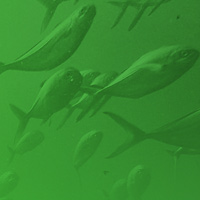
A Dominican rice farmer points out an invasive snail.
Jose Garcia used to dump chemicals on his rice fields in the Dominican Republic to kill snails. He’d flood the fields with water and fertilize them liberally, under the impression that more is better.
Today, thanks to the efforts of the conservation group AgroFrontera, he captures snails in special trenches rather than killing them with chemicals. He carefully measures his water and fertilizer usage, determining through soil testing how much the fields really need. And he’s replaced highly toxic organophosphates with greener herbicides and pesticides.
Garcia only hears of climate change now and then when watching the Discovery Channel — it’s not something much on the minds of the thousands of farmers who make a hard-scrabble living growing rice on the Dominican Republic’s northwest coast. But whether they know it or not, adopting sustainable farming methods is key to helping the region survive the effects of climate change — increasing storms, rising sea level, coral reef bleaching — which threaten to wreak havoc on the highly biodiverse and sensitive local ecosystem, including the nearby Monte Cristi national park.

A rice farmer monitors the irrigation flow.
Fertilizer and chemical run-off and exorbitant fresh water use by rice farmers pose serious threats to the fragile coastal ecosystem, since the water that flows through rice paddies picks up pollutants and makes its way into streams feeding the national park’s wetlands.
As this ecosystem is increasingly stressed by the effects of climate change, the pollution from rice paddies is a hard burden to bear. And ironically long-standing rice farming methods passed down from father to son are a significant source of the greenhouse gases that cause climate change. Local farmers typically burn rice stalks at the end of the season, releasing carbon dioxide; or allow them to rot in flooded fields, causing the release of methane — an even more powerful greenhouse gas.
“Rice is the most economically important crop in the region,” noted Dr. Freddie Payton, executive director of AgroFrontera, a local partner of the MacArthur-funded group Counterpart International. “It’s also the most polluting crop.”

Rice fields in the Dominican Republic.
So AgroFrontera is working with local farmers to encourage more sustainable methods. That means lightly folding old rice stalks into the soil instead of burning or soaking them. And using mechanical or organic methods to fight snails and other pests rather than bombarding them with chemicals. It also means persuading farmers to use less water and fertilizer.
AgroFrontera technician Ramon Moran, who grew up in the area, noted that wiser water and fertilizer use can actually increase crop yields.
“We’re always interested in learning more about science-based approaches to improving production,” added Garcia, 35, who started farming with his father at age 11 and now works four hectares.
Coastal wetlands, rice paddies and other parts of the Dominican Republic were included in a preliminary assessment of climate change impacts on biodiversity in the Caribbean funded in 2007 by the MacArthur Foundation and coordinated by with the Caribbean Natural Resources Institute (CANARI).
A recent technical report which is part of the assessment notes that migratory birds, reptiles and amphibians have increasingly taken up residence in rice paddies as coastal wetlands are being degraded. So the Dominican farmers’ new sustainable techniques also benefit these creatures: less toxic chemicals and exorbitant amounts of fertilizer applied to the rice fields means a healthier environment for all.



